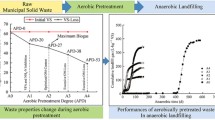Abstract
To reliably predict field operation performance derived from lab-based tests, it is very important to observe and consider all the specific landfill-site properties. The purpose of this study was to suggest and discuss the availability of batch and lysimeter tests to estimate the oxygen amount and the aeration period. To achieve this purpose, a comparison between lab test (batch and lysimeter tests) and full-scale applications was conducted. This study showed that aerobic batch and lysimeter tests could be used to estimate the amount of oxygen (mg-O2/g-DM) required to bio-stabilize landfilled wastes within a short period of time. In addition, aeration periods necessary to reach the target value can be calculated by a first-order kinetic depending on moisture content. Therefore, this study suggests that when applying in situ aeration processes to field-scale landfills, the amount of aeration required to bio-stabilize landfilled wastes has to be determined by the aerobic batch test, and then the aeration period required to reach the target value can be calculated by a reliable monitoring of the oxygen concentration in a landfill site in combination with the first-order kinetic.









Similar content being viewed by others
References
Ritzkowski M, Heyer K-U, Stegmann R (2006) Fundamental processes and implications during in situ aeration of old landfills. Waste Manag 26:356–372
Heyer K-U, Hupe K, Ritzkowski M, Stegmann R (2005) Pollutant release and pollutant reduction—impact of the aeration of landfills. Waste Manag 25:353–359
Read AD, Hudgins M, Harper S, Phillips P, Morris J (2001) The successful demonstration of aerobic landfilling—the potential for a more sustainable solid waste management approach? Resour Conserv Recycl 32:115–146
Rich C, Gronow J, Voulvoulis N (2008) The potential for aeration of MSW landfills to accelerate completion. Waste Manag 28:1039–1048
Ritzkowski M, Stegmann R (2012) Landfill aeration worldwide: concepts, indications and findings. Waste Manag 32:1411–1419
Das KC, Smith MC, Gattie DK, Hale Boothe DD (2002) Stability and quality of municipal solid waste compost from a landfill aerobic bioreduction process. Adv Environ Res 6:401–409
Ritzkowski M, Stegmann R (2005) Mechanisms affecting the leachate quality in the course of landfill in situ aeration. In: Proceedings Sardinia 2005, 10th international waste management and landfill symposium. Cagliari, Italy
Ritzkowski M, Stegmann R (2007) Controlling greenhouse gas emissions through landfill in situ aeration. Int J Greenh Gas Con 1:281–288
Park JK, Lee NH, Yoon SP (2011) Change in biodegradability of landfilled wastes by field-scale aerobic landfill stabilization (in Korea). J Korea Soc Waste Manag 28:242–248
Raga R, Cossu R (2013) Bioreactor tests preliminary to landfill in situ aeration: a case study. Waste Manag 33:871–880
Mertoglu B, Calli B, Inanc B, Ozturk I (2006) Evaluation of in situ ammonia removal in an aerated landfill bioreactor. Process Biochem 41:2359–2366
Ritzkowski M, Stegmann R (2013) Landfill aeration within the scope of post-closure care and its completion. Waste Manag 33:2074–2082
Prantl R, Tesar M, Huber-Humer M, Lechner P (2006) Changes in carbon and nitrogen pool during in situ aeration of old landfills under varying conditions. Waste Manag 26:373–380
Hard M, Gamperling O, Huber-Humer M (2013) Comparison between lab- and full-scale application of in situ aeration of an old landfill and assessment of long-term emission development after completion. Waste Manag 33:2061–2073
Zanetti MC (2008) Aerobic biostabilization of old MSW landfills. Am J Eng Appl Sci 1:393–398
Iannotti DA, Pang T, Toth BL, Elwell DL, Keener HM, Hotitnk HAJ (1993) A quantitative respirometric method for monitoring compost stability. Compost Sci Util 1:52–65
Adani F, Confalonieri R, Tambone F (2004) Dynamic respiration index: a measure of biological stability for organic matrices. J Environ Quality 33:1866–1876
Scaglia B, Erriquens FG, Gigliotti G, Taccari M, Ciani M, Genevini PL, Adani F (2007) Precision determination for the specific oxygen uptake rate (SOUR) method used for biological stability evaluation of compost and biostabilized products. Bioresour Technol 98:706–713
Cossu R, Raga R (2008) Test methods for assessing the biological stability of biodegradable waste. Waste Manag 28:381–388
Park JK, Jeong SR, Kim K, Yoon SP, Lee BS, Lee NH (2012) Assessment of oxygen uptake rate for landfilled solid wastes using a large-scale respirometer (in Korea). J Korea Society Waste Manag 29:11–18
Adani F, Lozzi P, Genevini PL (2001) Determination of biological stability by oxygen uptake on municipal solid waste and derived products. Compost Sci Util 9:52–65
Kallel A, Matsuto T, Tanaka N (2003) Determination of oxygen consumption for landfilled municipal solid wastes. Waste Manag Res 21:346–355
Shewfelt K, Lee H, Zytner RG (2005) Optimization of nitrogen for bioventing of gasoline contaminated soil. J Environ Eng Sci 4:29–42
Liang C, Das KC, McClendon RW (2003) The influence of temperature and moisture contents regimes on the aerobic microbial activity of a biosolids composting blend. Bioresour Technol 86:131–137
Pommier S, Chenu D, Quintard M, Lefebvre X (2008) Modelling of moisture-dependent aerobic degradation of solid waste. Waste Manag 28:1188–1200
Haug RT (1993) The Practical handbook of compost engineering. Lewis Publishers, Boca Raton
Petric I, Selimbašić V (2008) Development and validation of mathematical model for aerobic composting process. Chem Eng J 139:304–317
Acknowledgments
This study is supported by the Korea Ministry of Environment as “The Eco-technopia 21 project”.
Author information
Authors and Affiliations
Corresponding author
Rights and permissions
About this article
Cite this article
Lee, NH., Park, JK., Kang, JY. et al. Method to estimate the required oxygen amount and aeration period for the completion of landfill aeration. J Mater Cycles Waste Manag 18, 695–702 (2016). https://doi.org/10.1007/s10163-015-0370-2
Received:
Accepted:
Published:
Issue Date:
DOI: https://doi.org/10.1007/s10163-015-0370-2




